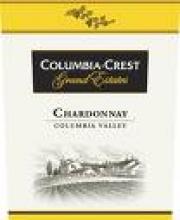Having resolved to give Chardonnay a second chance, and to specifically try more Washington Chardonnays, I thought it was only fair to start by trying a California Chardonnay. I'm looking at the "budget" category, since I'm quite sure my former employer wouldn't pay more than $10.00 a bottle for staff parties, but given the popularity of Chardonnay, that's not really a huge issue; there are far more "budget" tier Chardonnays locally than there are almost any other varietal.
Meridian Chardonnay
Merridian is very much a solid, reliable California winery, one that frequently appears on the wine lists of California restaurants. It's not one of the Chardonnays I experienced at work, but it's very widely distributed and it might have been. This is what I thought Chardonnay was, slightly acidic, tannic, though this is much more enjoyable than I expected it to be, definitely not the sort of thing served at the office parties I went to (maybe I'm in the wrong industry for decent wine at parties), and it's much better with food. This is a California "big wine" style Chardonnay; it's robust, almost pungent. I could very much see this as the wine to use in making a cheese fondue, as well as serve with cheese fondue, but this particular Chardonnay does rather need food.
Red Diamond Chardonnay
This is also very different, and mellower, than the California Chardonnay I'm used to. It's more fruity than tannin, not acidic or sharp at all. It's quaffable—in some ways, this reminds me of a pear cider that's been over-sweetened with pear juice after fermenting. According to the Web site, much of the wine was fermented for five months in aged French and American oak barrels, and the rest in stainless steel tanks. It's a bit of a non-entity, but that's not necessarily bad. It's the sort of thing I might offer to someone who doesn't like wine. It's forgettable but not at all unpleasant, and very very different from the equivalent in California Chardonnay terms.
Two Vines Chardonnay
The Washington Chardonnay that's made me reappraise my views on Chardonnay was a Columbia Crest Two Vines Chardonnay, and it was lovely. I suppose in hindsight, I shouldn't have been quite so surprised to discover I liked it, given how much I like the Two Vines Vineyard 10 White blend, which is predominantly Washington Chardonnay.
Columbia Grand Estates Chardonnay 2007
Chardonnay for grownups; lovely on its own, and an asset to food. A very definite pear aroma, and even a slightly pear-cider taste, but full bodied, with just
the right touch of oak. Honestly, if someone had told me that Chardonnay could be a bit like pear cider, I'd have been a lot more enthusiastic about trying California Chardonnays. The Grand Estates Charddonnay appeals to me even more than the Columbia Crest Two Vines, and at $8.99, it's a steal. I note that Wine Spectator gave this wine 89 points; last year's version was rated at 90, and a "best buy." I note that they use the somewhat controversial practice of re-innoculating the wine with carefully chosen cultures to convert the naturally occurring lactic acid to the also naturally occurring malic acid, in order to affect the flavor and aroma of the wine. Lactic acid is associated with the "buttery" taste of Chardonnay, while malic acid is associated with the more acidic "green apple" tastes and aromas. After an initial fermentation in order to kick-start malolactic fermentation, the barrels are all hand-stirred for six months, then blended after six more months in barrels.I'm now convinced that I do like Chardonnay, especially Washington Chardonnay, and am ready to start looking at slightly more expensive Chardonnays from Washington. I liked the Grand Estates Chardonnay enough to look for the mid-range Columbia Crest Chardonnay, the Columbia Crest Horse Heaven Hills (H3) version, as well as their Columbia Crest Reserve Chardonnay. I'm thinking Washington Chardonnay bears a bit more attention.
